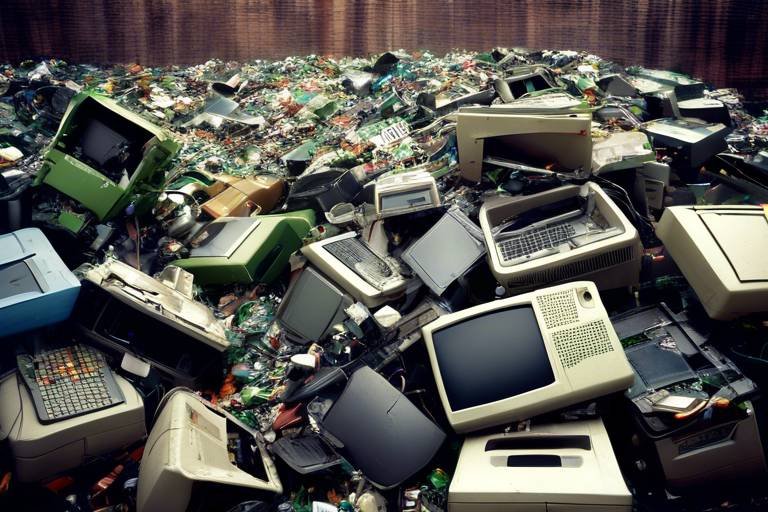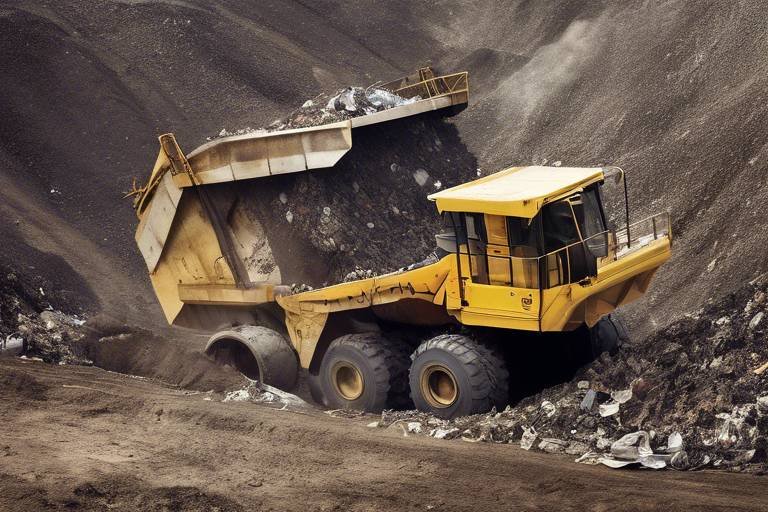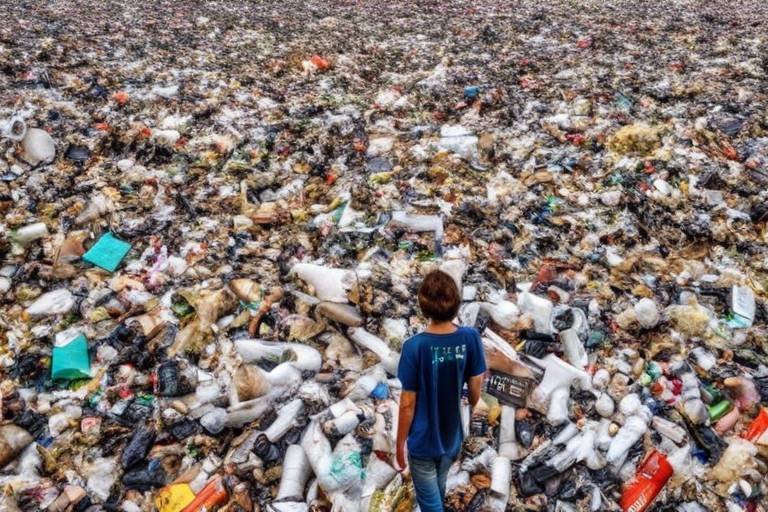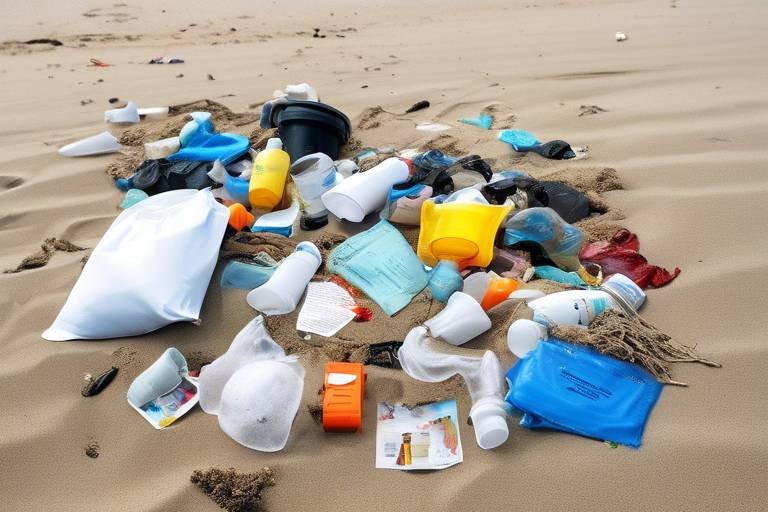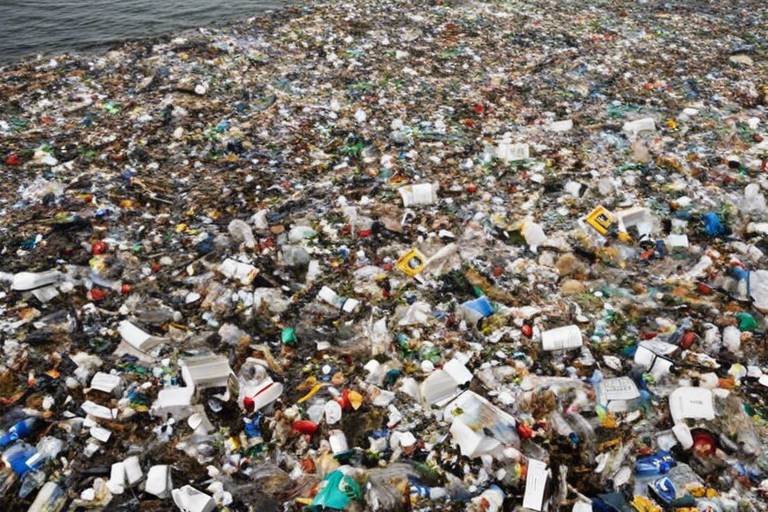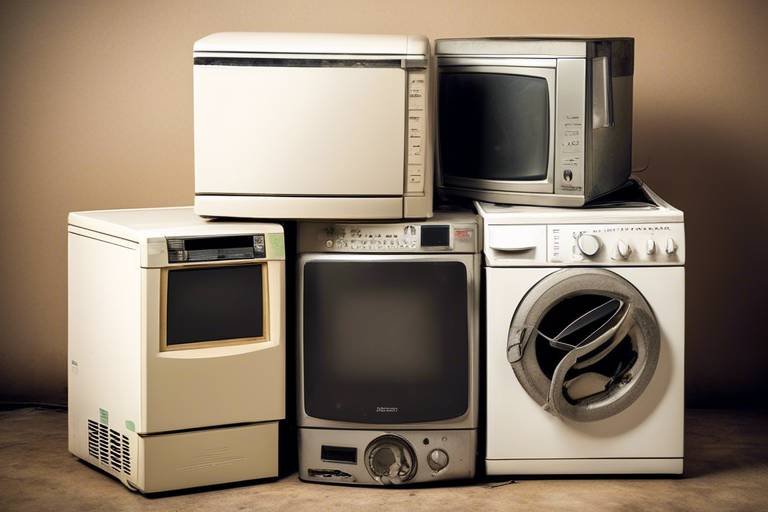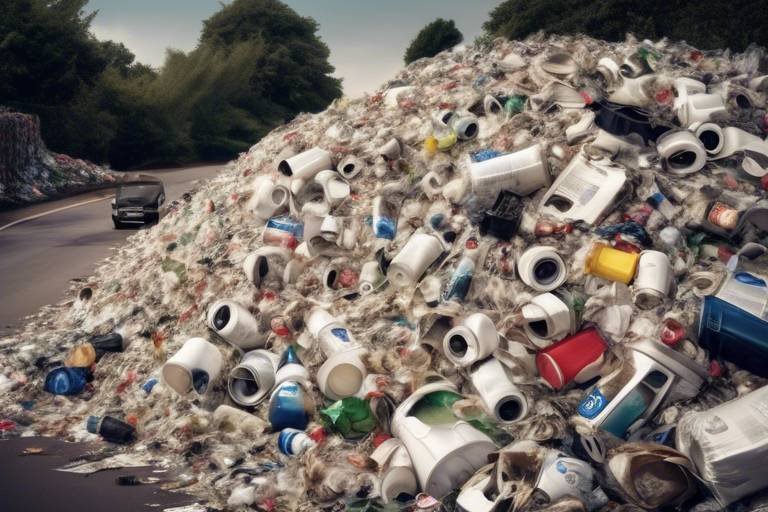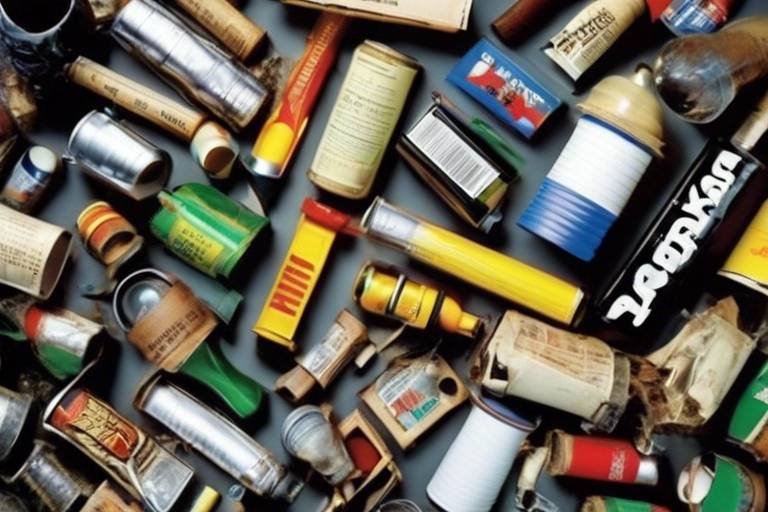How Does E-Waste Recycling Work?
E-waste recycling is a fascinating process that not only helps in managing the growing problem of electronic waste but also plays a crucial role in conserving our planet's resources. Imagine a world where your old gadgets don’t just end up in a landfill, but instead are transformed into new products or valuable materials. This is the magic of e-waste recycling! In this article, we will explore the intricacies of how e-waste recycling works, the steps involved, and its significance for both the environment and society.
To kick things off, let’s talk about what e-waste actually is. E-waste, or electronic waste, refers to discarded electrical or electronic devices. This includes everything from old smartphones and laptops to broken TVs and outdated gaming consoles. As technology advances at breakneck speed, our old devices quickly become obsolete, leading to a staggering amount of e-waste. In fact, according to the Global E-Waste Monitor, over 53 million metric tons of e-waste was generated in 2019 alone, and this number is expected to rise significantly in the coming years.
The recycling process itself is not just about tossing your old electronics into a bin and hoping for the best. It involves a series of well-defined steps designed to ensure that valuable materials are recovered and harmful substances are disposed of safely. The journey begins with the collection of e-waste, which can occur through various methods. Once collected, the e-waste is then sorted and dismantled to separate different components, making it easier to recycle materials like metals, plastics, and glass.
Understanding the recycling process is crucial for anyone looking to dispose of their electronic devices responsibly. The key steps involved in e-waste recycling include:
- Collection: E-waste is gathered through various channels, including curbside pickups, drop-off centers, and designated recycling programs.
- Dismantling: The collected e-waste is taken to recycling facilities where it is dismantled into its individual components.
- Sorting: Different materials are sorted, allowing for efficient recovery of valuable resources.
- Recovery: Valuable materials such as gold, copper, and plastics are extracted and prepared for reuse in new products.
- Safe Disposal: Any hazardous materials are disposed of in accordance with environmental regulations to prevent pollution.
It’s essential to recognize that e-waste recycling not only conserves natural resources but also helps reduce pollution. By recovering materials from old electronics, we can decrease the need for mining new materials, which often leads to environmental degradation. Moreover, responsible recycling practices mitigate the risks associated with hazardous substances found in electronics, such as lead, mercury, and cadmium, which can leach into the soil and water if not handled properly.
As we delve deeper into the recycling process, we will discover the various collection methods available for consumers and businesses. By participating in these programs, individuals can ensure that their electronic devices are disposed of responsibly, contributing to a healthier planet.
Q1: What types of electronics can be recycled?
A1: Most electronic devices can be recycled, including computers, smartphones, tablets, televisions, and gaming consoles. Always check with your local recycling program for specific guidelines.
Q2: Is there a cost associated with e-waste recycling?
A2: Many municipalities offer free e-waste recycling programs, while some specialized recycling facilities may charge a fee for certain items. It's best to research local options.
Q3: Can I just throw my e-waste in the regular trash?
A3: No, it is not advisable to dispose of e-waste in regular trash as it can lead to environmental hazards. Always use designated recycling programs to ensure safe disposal.
Q4: How can I find a recycling program near me?
A4: You can search online for local e-waste recycling programs or check with your city's waste management department for information on drop-off locations and collection events.

The E-Waste Problem
E-waste, or electronic waste, is rapidly becoming one of the most pressing environmental challenges of our time. As technology advances at lightning speed, millions of tons of obsolete electronics are discarded each year. In fact, the World Economic Forum estimates that globally, we generate over 50 million tons of e-waste annually, a staggering figure that continues to rise. So, why should we care? The answer lies in the environmental hazards associated with improper disposal.
When electronic devices reach the end of their life cycle, many people simply toss them in the trash, unaware of the potential dangers. Items like smartphones, computers, and televisions contain hazardous materials such as lead, mercury, and cadmium. These substances can leach into the soil and waterways, posing serious health risks to both humans and wildlife. For instance, lead exposure can lead to neurological damage, particularly in children, while mercury can contaminate fish, making them unsafe to eat.
The types of e-waste generated are diverse and include:
- Computers and laptops
- Smartphones and tablets
- Televisions and monitors
- Home appliances like microwaves and refrigerators
- Audio and video equipment
As we look around, it’s easy to see that nearly every household has some form of electronic device that will eventually become e-waste. The problem is compounded by the rapid turnover of technology; consumers are encouraged to upgrade to the latest models, leaving behind a trail of discarded devices. This cycle not only fills landfills but also squanders valuable resources. Did you know that recycling just one million laptops can save enough energy to power over 3,500 homes for a year? That’s the potential we’re wasting!
In addition to the environmental and health concerns, the economic implications of e-waste are significant. The materials found in e-waste, such as gold, silver, and rare earth elements, are valuable. However, only a fraction of these materials are recovered through current recycling methods. This leads to a waste of resources that could otherwise be reused, contributing to a more sustainable economy.
In summary, the e-waste problem is not just a minor inconvenience; it represents a complex web of environmental, health, and economic challenges. As we continue to embrace technology, it’s crucial to understand the implications of our electronic consumption and disposal habits. The next time you think about tossing that old gadget, consider the impact it might have on our planet. Are you ready to take responsibility for your e-waste?

Understanding the recycling process of e-waste is crucial for anyone interested in contributing to a more sustainable environment. The journey of electronic waste from our hands to its rebirth as new materials involves several intricate steps, each designed to maximize recovery while minimizing environmental impact. The process begins with the collection of e-waste, where various methods are employed to gather discarded electronics from consumers and businesses alike.
Once the e-waste is collected, the next step is sorting. This is where the magic truly begins! At this stage, items are categorized based on their type and material composition. For instance, old televisions, computers, and mobile phones each have different components that require specific recycling techniques. This sorting process is essential because it ensures that hazardous materials, such as lead and mercury, are handled appropriately, preventing them from contaminating the environment.
After sorting, the e-waste undergoes dismantling. This is a meticulous process where skilled workers carefully take apart the devices to access valuable components. Think of it as a treasure hunt; each device holds precious metals like gold, silver, and copper, which can be extracted and reused. Dismantling not only allows for the recovery of these materials but also ensures that any hazardous components are safely disposed of.
Next comes the recovery phase, where the separated materials are processed for reuse. This can include shredding plastic casings, melting down metals, and refining precious materials. The recycling facilities utilize advanced technology to enhance recovery rates, ensuring that as much material as possible is salvaged from the e-waste. For example, a typical recycling facility can recover up to 90% of the metals from old electronics, which is a significant contribution to resource conservation.
Moreover, it’s important to highlight that the recycling process doesn’t stop at just material recovery. The entire operation is designed with sustainability in mind. By recycling e-waste, we reduce the need for virgin materials, which in turn minimizes the energy consumption and pollution associated with mining and manufacturing new products. In essence, e-waste recycling is not just about getting rid of old gadgets; it’s about creating a circular economy where materials are reused and repurposed, leading to a healthier planet.
In summary, the recycling process of e-waste is a complex yet vital operation that involves collection, sorting, dismantling, and recovery. Each step plays a critical role in ensuring that valuable materials are salvaged while hazardous substances are carefully managed. By understanding this process, we can all take part in reducing e-waste and promoting a more sustainable future.
- What types of electronics can be recycled? Most electronic devices, including computers, televisions, smartphones, and printers, can be recycled. However, it's best to check with local recycling programs for specific guidelines.
- Is e-waste recycling safe? Yes, when done through certified recycling facilities, e-waste recycling is safe and helps prevent environmental contamination.
- How can I find a recycling center near me? Many municipalities have designated drop-off centers or curbside pickup programs. You can also check online for local e-waste recycling events.
- What happens to my data when I recycle my device? Reputable recycling facilities take data security seriously. They often provide data wiping services or ensure that devices are destroyed in a way that protects your information.

When it comes to e-waste recycling, the first crucial step is the collection of electronic devices that have reached the end of their life cycle. This process can seem daunting, but it is essential for ensuring that harmful materials are disposed of responsibly and valuable resources are recovered. There are several effective collection methods that communities and individuals can utilize to ensure their e-waste is handled properly.
One popular method is through designated recycling programs, often organized by local governments or environmental organizations. These programs typically include scheduled collection events where residents can drop off their old electronics, ensuring they are processed by certified recyclers. It's almost like a community yard sale, but instead of selling old items, you're giving them a second chance at life through recycling.
Another convenient option is curbside pickup programs. Many municipalities have recognized the importance of e-waste recycling and have implemented services that allow residents to place their unwanted electronics at the curb on designated days. This method is particularly beneficial for those who may not have easy access to drop-off centers. Imagine the ease of simply walking to your front yard and leaving your old television or computer for collection—how simple is that?
For those who prefer to take a more active role in the recycling process, drop-off centers are a fantastic alternative. These centers are often strategically located throughout communities, making it easy for individuals to bring their e-waste at their convenience. Operating hours may vary, but many centers are open during weekends and evenings, accommodating busy schedules. A quick visit to a drop-off center can help you declutter your home while contributing to a greener planet.
| Collection Method | Description | Benefits |
|---|---|---|
| Designated Recycling Programs | Scheduled events for residents to drop off e-waste. | Community engagement, safe disposal. |
| Curbside Pickup | Collection of e-waste from the curb on designated days. | Convenience, accessibility for all residents. |
| Drop-off Centers | Locations where individuals can bring their e-waste. | Flexible hours, direct recycling. |
It's important to remember that not all electronic devices are created equal when it comes to recycling. While many items can be recycled, others may require special handling due to hazardous materials. Therefore, before you toss your old gadgets into the recycling bin, it’s wise to check with your local recycling program about what is accepted. This way, you can ensure you are doing your part without inadvertently causing harm to the environment.
In conclusion, the collection methods for e-waste recycling are designed to make the process as simple and effective as possible. By participating in these programs, whether through curbside pickup, designated events, or drop-off centers, you are contributing to a larger movement towards sustainability. Every small action counts, and by responsibly disposing of your electronic waste, you're helping to pave the way for a cleaner, greener future.
Q: What types of electronics can be recycled?
A: Most electronic devices, including computers, televisions, smartphones, and printers, can be recycled. However, it’s best to check with your local program for specific guidelines.
Q: Are there any fees associated with e-waste recycling?
A: Some programs may charge a small fee for certain items, especially larger electronics. Always confirm with your local recycling program for details.
Q: What happens to my e-waste after it is collected?
A: Once collected, e-waste is transported to a recycling facility where it is dismantled, sorted, and processed. Valuable materials are recovered, and hazardous substances are disposed of safely.
Q: Can I recycle my e-waste at any time?
A: While drop-off centers may have flexible hours, designated collection events and curbside pickups are scheduled at specific times. It’s best to check the schedule ahead of time.

Curbside pickup programs are an innovative solution that many municipalities have adopted to make e-waste recycling more accessible for residents. Imagine being able to toss your old electronics into a designated bin right from your driveway—it's that simple! These programs are designed to encourage responsible disposal of electronic waste by providing a convenient way for households to recycle their unwanted devices without the hassle of traveling to a drop-off center.
Typically, these programs operate on a scheduled basis, meaning that residents can set aside their e-waste for collection on specific days. To participate, all you need to do is check your local municipality's website or contact your waste management department to find out the schedule and guidelines. It's crucial to follow the rules, as improper disposal can lead to contamination and negate the benefits of recycling.
Here are some key features of curbside pickup programs that make them beneficial:
- Convenience: No need to haul heavy electronics to a recycling center; just place them at the curb.
- Increased Participation: By making recycling easier, more people are likely to take part, reducing the amount of e-waste in landfills.
- Environmental Impact: Properly recycling e-waste helps recover valuable materials and reduces pollution.
However, it's important to note that not all items are eligible for curbside pickup. Most programs accept common household electronics such as televisions, computers, and small appliances, but you'll want to double-check the specific list of accepted items to avoid any surprises. Additionally, some areas may require residents to register for the service or limit the number of items collected per household.
In conclusion, curbside pickup programs are a fantastic way to facilitate e-waste recycling, making it easier for individuals to contribute to a more sustainable future. By taking advantage of these services, you not only declutter your home but also play a vital role in protecting the environment. So, next time you're ready to part with an old gadget, consider putting it out for curbside pickup—it's a win-win for you and the planet!

Drop-off centers serve as a vital link in the chain of responsible e-waste disposal, providing a convenient and accessible way for individuals and businesses to recycle their old electronics. These centers are strategically located in various communities, making it easier for residents to find a nearby location to dispose of their unwanted devices. Imagine having a local hub where you can drop off your old laptops, smartphones, and other electronic gadgets, knowing that they will be handled properly and recycled in an environmentally friendly manner.
Typically, drop-off centers operate during specific hours, allowing you to plan your visit accordingly. Most centers accept a wide range of electronic items, including:
- Computers and laptops
- Monitors and TVs
- Printers and scanners
- Smartphones and tablets
- Home appliances like microwaves and refrigerators
Before heading to a drop-off center, it's a good idea to check their website or contact them for information on accepted items and operating hours. Some centers may even host special events or collection days, providing additional opportunities for you to recycle your e-waste responsibly. By utilizing these centers, you not only contribute to reducing the amount of e-waste that ends up in landfills but also support the recovery of valuable materials that can be reused in new products.
In addition to local drop-off centers, many retailers and manufacturers have implemented their own recycling programs, allowing you to return your old electronics when purchasing new items. This creates a seamless recycling experience and encourages a culture of sustainability. So, the next time you're ready to upgrade your devices, consider taking advantage of these drop-off options to ensure your old electronics are disposed of responsibly.
Q: What types of electronics can I drop off at these centers?
A: Most drop-off centers accept a wide range of electronic items, including computers, televisions, smartphones, and appliances. However, it's always best to check with your local center for specific guidelines.
Q: Are there any fees associated with dropping off e-waste?
A: Many drop-off centers offer free recycling services, but some may charge a small fee for certain items, like TVs or appliances. Always verify before you go!
Q: Can I drop off broken electronics?
A: Yes, most drop-off centers accept broken electronics, as they can still be dismantled for parts and materials.
Q: How can I find a drop-off center near me?
A: You can search online for local e-waste recycling centers or check with your municipality for designated drop-off locations.

Dismantling and sorting are crucial steps in the e-waste recycling process, acting as the gateway to recovering valuable materials and ensuring that hazardous components are handled safely. When e-waste is collected, it often contains a mix of various devices, each with its own unique components. This complexity makes the dismantling phase not just necessary but essential for effective recycling. Imagine a treasure chest filled with both gold and junk; without careful sorting, the valuable gold could easily be lost amidst the clutter.
The first step in this phase is to carefully dismantle the electronic devices. Skilled workers or automated systems take apart items like old computers, smartphones, and televisions, breaking them down into their individual components. This process involves removing the outer casing, circuit boards, batteries, and other internal parts. Each component must be treated with care, as some can contain harmful substances like lead or mercury, which pose risks to both human health and the environment.
Once dismantling is complete, the next step is sorting these components into different categories. This is where the magic happens, as various materials are separated for recycling. The sorting process can be categorized into several key types:
- Metals: These include precious metals like gold, silver, and copper, as well as base metals such as aluminum and steel. They are highly sought after and can be recycled indefinitely without losing their properties.
- Plastics: Different types of plastics are sorted based on their resin types, which is crucial for effective recycling. For instance, polycarbonate and ABS plastics are common in electronics and can be reprocessed into new products.
- Circuit Boards: These are often rich in valuable metals and require special handling. They are usually sent to specialized facilities for further extraction of precious metals.
- Hazardous Materials: Items like batteries and cathode ray tubes (CRTs) must be carefully handled and disposed of according to regulations to prevent environmental contamination.
Advanced technologies play a significant role in enhancing the efficiency of the dismantling and sorting processes. Automated systems, such as shredders and magnetic separators, can quickly process large volumes of e-waste, allowing for a more streamlined operation. However, human oversight remains critical, as certain components require manual intervention to ensure safety and compliance with environmental standards.
Ultimately, the goal of dismantling and sorting in e-waste recycling is to maximize the recovery of valuable materials while minimizing the environmental impact. By efficiently separating components, we not only conserve resources but also reduce the amount of waste that ends up in landfills. In this way, dismantling and sorting serve as the backbone of a sustainable recycling ecosystem, paving the way for a cleaner, greener future.
- What types of materials can be recycled from e-waste? Most electronic devices contain metals, plastics, and glass that can be recycled. Additionally, precious metals like gold and silver can be extracted from circuit boards.
- Is it safe to dismantle e-waste at home? It is not recommended to dismantle e-waste at home due to the presence of hazardous materials. Always use certified e-waste recycling facilities.
- How can I find a recycling program near me? Check local government websites or search for certified e-waste recycling centers in your area. Many municipalities offer designated drop-off locations.
- What happens to the materials after they are sorted? Recycled materials are sent to manufacturers who process them into new products, reducing the need for raw materials and minimizing environmental impact.

E-waste recycling is not just a trend; it's a vital practice that brings about significant environmental benefits. In a world where technology evolves at lightning speed, our electronic devices become obsolete faster than you can say "upgrade." This rapid turnover leads to a staggering amount of electronic waste, which, if not managed properly, can wreak havoc on our planet. So, what exactly are the environmental benefits of recycling e-waste, and why should we all care?
First and foremost, recycling e-waste conserves precious natural resources. Many electronic devices contain valuable metals like gold, silver, and copper, which require extensive mining operations to extract. By recycling these materials, we reduce the need for mining, which is often detrimental to ecosystems. For instance, the extraction of metals can lead to deforestation, soil degradation, and water contamination. By opting for recycling, we are effectively saying "no" to these harmful practices and "yes" to sustainability.
Moreover, e-waste recycling plays a crucial role in reducing pollution. When electronic devices are improperly disposed of, they can release toxic substances such as lead, mercury, and cadmium into the environment. These hazardous materials can contaminate soil and water, posing serious health risks to humans and wildlife alike. By recycling e-waste, we can ensure that these harmful substances are handled safely, preventing them from entering our ecosystems. It's like giving Mother Nature a much-needed detox!
Additionally, recycling helps in mitigating climate change. The production of new electronics is energy-intensive, contributing significantly to greenhouse gas emissions. By recycling existing materials, we can significantly reduce the energy required to manufacture new devices. In fact, according to studies, recycling one million laptops can save the energy equivalent to the electricity used by 3,500 homes in a year. So, every time you recycle an old gadget, you're not just clearing out your closet; you're also playing a role in combating climate change.
To illustrate the impact of e-waste recycling, consider the following table:
| Benefit | Impact |
|---|---|
| Resource Conservation | Reduces the need for raw material extraction |
| Pollution Reduction | Prevents toxic substances from contaminating the environment |
| Energy Savings | Decreases energy consumption and greenhouse gas emissions |
In conclusion, the environmental benefits of e-waste recycling are profound and far-reaching. By recycling our electronic devices, we conserve resources, reduce pollution, and help combat climate change. It's a win-win situation for both the planet and us! So, the next time you upgrade your phone or laptop, think about the impact your decision can have on the environment. Let’s make responsible choices and contribute to a healthier planet.
- What types of e-waste can be recycled? Most electronic devices, including smartphones, computers, and televisions, can be recycled. Check with local recycling centers for specific guidelines.
- How does e-waste recycling benefit the economy? Recycling creates jobs in the recycling industry and reduces the costs associated with waste management and pollution cleanup.
- Can I recycle e-waste at home? While some small items can be recycled at home, it’s best to take larger electronics to designated recycling centers to ensure proper handling.

The journey of e-waste recycling is not as straightforward as it may seem. Despite its numerous benefits, the process is fraught with challenges that hinder effective management of electronic waste. One of the most pressing issues is **illegal dumping**. This occurs when individuals or businesses dispose of their e-waste in unauthorized locations, leading to significant environmental hazards. Imagine a beautiful park turned into a dumping ground for old TVs and computers; it’s not just an eyesore, but it also poses serious health risks to both the ecosystem and nearby communities.
Another challenge is the **lack of awareness** among consumers regarding the proper disposal methods for e-waste. Many people are simply unaware of the potential dangers associated with throwing electronics in the trash. It’s like throwing a ticking time bomb into a landfill; the toxic materials inside devices can leach into the soil and groundwater, causing long-term damage. Education and outreach programs are essential to inform the public about the importance of recycling e-waste responsibly.
Moreover, the **complexity of recycling various electronic components** adds another layer of difficulty. E-waste is not a one-size-fits-all category; it includes a wide range of devices, each with its unique materials and components. For instance, a smartphone contains metals, plastics, and glass, while a computer may have circuit boards and batteries. The recycling processes for these materials can differ significantly, making it challenging for recycling facilities to efficiently recover valuable resources. In fact, according to recent studies, only about 20% of e-waste is actually recycled properly, with the rest ending up in landfills or incinerators.
Regulatory issues also play a critical role in the challenges faced by e-waste recycling. Current laws and policies governing e-waste management can be inconsistent and, in some cases, poorly enforced. This lack of regulation can lead to improper disposal practices, which exacerbate the environmental crisis. Stricter enforcement of existing laws and the introduction of new regulations are needed to ensure that e-waste is handled responsibly.
Lastly, **technological barriers** present a significant hurdle in the recycling of electronic waste. While advancements in technology have the potential to improve recycling processes, many facilities still rely on outdated methods that are not as efficient. Innovations in material recovery techniques are crucial to enhance the recycling rates of valuable materials found in e-waste. For example, new technologies could potentially recover more precious metals from circuit boards, which are often lost in traditional recycling methods.
In summary, the challenges in e-waste recycling are multifaceted and require a concerted effort from consumers, businesses, and policymakers. By addressing illegal dumping, raising awareness, simplifying recycling processes, enforcing regulations, and embracing technological advancements, we can pave the way for a more sustainable future. Together, we can turn the tide on the e-waste crisis and protect our planet for generations to come.
- What is e-waste? E-waste refers to discarded electronic devices such as computers, smartphones, and televisions.
- Why is e-waste recycling important? It helps conserve resources, reduces pollution, and mitigates environmental hazards associated with improper disposal.
- How can I recycle my old electronics? You can recycle e-waste through curbside pickup programs, drop-off centers, or designated recycling events in your community.
- What happens to e-waste after it's collected? It undergoes a recycling process that includes dismantling, sorting, and recovering valuable materials.
- Are there any regulations for e-waste recycling? Yes, there are laws governing e-waste management, but enforcement can vary by location.

When it comes to the recycling of electronic waste (e-waste), regulatory issues play a pivotal role in shaping how we manage this growing problem. Many countries have established laws and regulations aimed at minimizing the environmental impact of e-waste. However, the effectiveness of these regulations can vary significantly, often leading to a patchwork of compliance and enforcement. For instance, while some regions have stringent policies that mandate proper disposal and recycling practices, others may lack comprehensive legislation altogether, creating loopholes that can be exploited.
One major challenge is the illegal dumping of e-waste. In areas where regulations are weak or poorly enforced, individuals and businesses may be tempted to dispose of their electronic devices in unauthorized locations, such as vacant lots or landfills. This not only poses serious environmental risks but also undermines legitimate recycling efforts. To combat this issue, many governments are now focusing on strengthening enforcement mechanisms and increasing penalties for illegal dumping.
Moreover, the complexity of e-waste itself presents regulatory challenges. Electronic devices often contain a mix of hazardous materials, such as lead, mercury, and cadmium, which require specialized handling. Regulations need to be clear and specific about how to manage these materials safely. This complexity leads to confusion among consumers and businesses alike, as they may not fully understand the regulations or how to comply with them. A lack of public awareness about e-waste regulations can exacerbate the problem, making it essential for governments to invest in educational campaigns that inform citizens about the proper ways to dispose of their electronic devices.
In addition, international regulations can complicate matters further. E-waste often crosses borders, and the lack of a unified global framework makes it challenging to manage. For example, the Basel Convention, an international treaty aimed at reducing the movement of hazardous waste between countries, has been a step in the right direction. However, enforcement remains a significant hurdle, as not all countries adhere to the same standards.
To illustrate the current landscape of e-waste regulations, consider the following table:
| Country/Region | Key Regulation | Enforcement Level |
|---|---|---|
| United States | Resource Conservation and Recovery Act (RCRA) | Moderate |
| European Union | Waste Electrical and Electronic Equipment Directive (WEEE) | High |
| India | E-Waste (Management) Rules | Low |
| China | Regulations on the Management of Waste Electrical and Electronic Products | Moderate |
In conclusion, addressing the regulatory issues surrounding e-waste recycling is crucial for creating a sustainable future. Governments must work towards establishing comprehensive, enforceable regulations that not only protect the environment but also educate the public on their responsibilities. By doing so, we can ensure that e-waste is managed effectively, reducing its harmful impact on our planet.
- What is e-waste? E-waste refers to discarded electronic devices such as computers, smartphones, and televisions that are no longer in use.
- Why is e-waste recycling important? Recycling e-waste helps conserve natural resources, reduces pollution, and mitigates the harmful effects of hazardous materials found in electronic devices.
- How can I properly dispose of my e-waste? You can dispose of e-waste through municipal curbside pickup programs, drop-off centers, or designated recycling events in your area.
- What are the risks of illegal e-waste dumping? Illegal dumping can lead to environmental contamination, health risks for nearby communities, and loss of valuable materials that could be recycled.

When it comes to e-waste recycling, technology plays a pivotal role, but it also introduces a set of challenges that can hinder effective recycling processes. One of the primary barriers is the rapid pace of technological advancement in electronics. Devices become obsolete at breakneck speed, leading to a constant influx of e-waste that recycling facilities struggle to keep up with. Imagine trying to catch a wave that keeps getting bigger and bigger; without the right tools, it’s nearly impossible to ride it successfully.
Another significant challenge is the complexity of electronic devices. Modern gadgets are often designed with an array of materials that can be difficult to separate and recycle. For instance, smartphones contain metals like gold, silver, and copper, as well as plastics and glass, all tightly integrated into a compact design. This intricate assembly makes dismantling a labor-intensive and time-consuming process. In fact, studies have shown that up to 60% of the materials in e-waste are not being recovered due to these complexities.
Moreover, many recycling facilities lack the advanced technology needed to efficiently process e-waste. While some facilities are equipped with outdated machinery, others may not have the resources to invest in the latest recycling technologies such as automated sorting systems and advanced shredders. This not only affects the volume of e-waste they can handle but also the quality of materials recovered. A recent report indicated that only 20% of e-waste is recycled properly, highlighting the urgent need for technological upgrades in the recycling sector.
To further complicate matters, there are also regulatory hurdles that can stifle innovation. Many countries have strict regulations governing the recycling of electronic waste, but these laws can vary widely. In some regions, the lack of clear guidelines makes it challenging for companies to adopt new technologies or processes. This regulatory inconsistency can lead to confusion and inefficiencies in recycling efforts.
Despite these barriers, there is hope on the horizon. Innovations in recycling technology are emerging, aimed at addressing these challenges. For example, companies are developing advanced robotic systems that can accurately sort materials at a fraction of the time it takes human workers. Additionally, new chemical processes are being researched that can help recover precious metals from e-waste more efficiently. The potential for these advancements to transform the recycling landscape is immense, but widespread adoption will require collaboration between industry stakeholders, governments, and technology developers.
In summary, while technological barriers present significant challenges to e-waste recycling, they also offer an opportunity for innovation and improvement. By investing in new technologies and fostering a regulatory environment that supports these advancements, we can enhance our recycling efforts and mitigate the environmental impact of electronic waste.
- What is e-waste? E-waste refers to discarded electronic devices such as computers, smartphones, and televisions that are no longer wanted or functional.
- Why is e-waste recycling important? Recycling e-waste helps conserve resources, reduces pollution, and minimizes the harmful effects of electronic waste on the environment.
- What are the challenges in e-waste recycling? Challenges include rapid technological advancement, complexity of devices, lack of advanced recycling technology, and regulatory hurdles.
- How can I responsibly dispose of my electronic devices? You can participate in curbside pickup programs, use drop-off centers, or seek out designated recycling programs in your area.

When it comes to e-waste disposal, following best practices is crucial not only for the environment but also for our health. With the rapid advancement of technology, we often find ourselves upgrading our devices more frequently than ever. This means that the pile of old electronics can grow quickly, leading to the pressing question: what do we do with all this e-waste? Here are some effective strategies to ensure that your electronic devices are disposed of responsibly.
First and foremost, always look for certified recycling programs. These programs are designed to handle e-waste properly and ensure that hazardous materials are processed safely. Many manufacturers and retailers have take-back programs where they accept old devices for recycling. This is a win-win situation: you get rid of your old tech, and they ensure it is recycled appropriately. For instance, companies like Apple and Best Buy have established programs that allow you to return old devices, often with incentives like discounts on new purchases.
Additionally, consider participating in local e-waste collection events. Many communities organize special days for residents to drop off their old electronics. These events are often free and provide an excellent opportunity to dispose of your e-waste responsibly. Not only does this help keep hazardous materials out of landfills, but it also raises awareness about the importance of recycling. Check your local government’s website for information on upcoming events.
Another important aspect is to erase personal data from your devices before recycling them. Whether it's a smartphone, laptop, or tablet, make sure to back up your data and perform a factory reset. This step is essential to protect your personal information from falling into the wrong hands. Many people overlook this step, but it’s as crucial as the recycling process itself. You wouldn’t want your sensitive information exposed, would you?
Moreover, if your device is still functional, consider donating it instead of recycling. Many organizations accept working electronics to help those in need. This not only extends the life of your device but also provides someone else with a valuable tool. Schools, charities, and community centers often welcome donations of laptops and tablets, especially if they can be used for educational purposes. It’s a simple yet effective way to give back to the community while reducing e-waste.
Lastly, educate yourself and others about the importance of e-waste recycling. Share information with friends and family about the hazards of improper disposal and the benefits of recycling. By spreading awareness, you can help create a culture of responsible disposal in your community. Remember, every small action counts, and together we can make a significant impact on our environment.
- What types of electronics can be recycled? Most electronic devices, including smartphones, computers, televisions, and printers, can be recycled. Check with your local recycling program for specific guidelines.
- Is it safe to donate my old electronics? Yes, as long as you erase your personal data before donating. Make sure to follow the necessary steps to protect your information.
- Are there any costs associated with e-waste recycling? Many local programs offer free recycling services, but some may charge a fee for specific items. Always check in advance.
- What happens to my e-waste after I drop it off? After collection, e-waste is sorted, dismantled, and processed to recover valuable materials while safely disposing of hazardous substances.
Frequently Asked Questions
-
What is e-waste?
E-waste, or electronic waste, refers to discarded electrical or electronic devices. This includes old computers, smartphones, televisions, and other gadgets that are no longer in use. With technology advancing rapidly, e-waste is one of the fastest-growing waste streams globally, making responsible disposal crucial.
-
Why is e-waste recycling important?
Recycling e-waste is vital for several reasons. It helps conserve natural resources by recovering valuable materials like copper, gold, and rare earth metals. Moreover, it reduces pollution and minimizes the harmful effects of e-waste on our ecosystems. Proper recycling can also prevent hazardous substances found in electronics from contaminating the environment.
-
How can I recycle my old electronics?
There are several ways to recycle your old electronics. You can participate in curbside pickup programs offered by some municipalities, or you can take your devices to designated drop-off centers. Many retailers also have recycling programs that allow you to return your old electronics when purchasing new ones.
-
What happens to my e-waste after I recycle it?
Once your e-waste is collected, it undergoes a series of processes including dismantling, sorting, and material recovery. Valuable components are extracted for reuse, while hazardous materials are handled according to environmental regulations. This ensures that as much material as possible is recycled, and harmful substances are disposed of safely.
-
Are there any challenges in e-waste recycling?
Yes, e-waste recycling faces several challenges such as illegal dumping, a lack of public awareness, and the complexities involved in recycling various electronic components. Additionally, regulatory issues and technological barriers can hinder effective recycling efforts, making it essential to promote better practices and policies.
-
What are the best practices for e-waste disposal?
To dispose of e-waste responsibly, consider the following best practices: always use certified recycling programs, avoid throwing electronics in regular trash, and educate yourself about local e-waste disposal options. Additionally, consider donating working devices to charities or recycling centers that can refurbish them for reuse.

